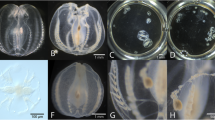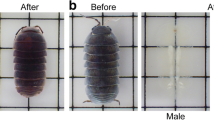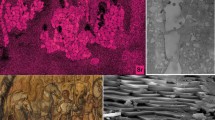Abstract
The houses of oikopleurid larvaceans are of such a delicate structure that their preservation and storage for reference collections and post-collection study has been essentially impossible. However, houses ofOikopleura dioica, O. labradoriensis andO. vanhoeffeni, ranging in size from 0.7 to 7 cm, may be dried onto glass slides or onto paper or membrane filters so that most structural details are maintained. The handling of houses during the drying process is greatly facilitated if they are prestained by particulate or colloidal dyes while still inhabited. Such staining also reveals a wealth of structural detail that is difficult to obtain by other means. Staining the house after mounting and drying is also possible, but more difficult. The described technique may be used for making permanent records of oikopleurid houses of all sizes, from the first post-metamorphic house of <1 mm diameter to the largest known oikopleurid house of perhaps 1 m diameter. Such records may serve both as taxonomic tools and as specimens for detailed structural and chemical analysis by high-power microscopes and microbeam instruments.
Similar content being viewed by others
Literature cited
Alldredge, A. L. (1977). House morphology and mechanisms of feeding in theOikopleuridae (Tunicata, Appendicularia). J. Zool. Lond. 181: 175–188
Barham, E. G. (1979). Giant larvacean houses: observations from deep submersibles. Science, N.Y. 205: 1129–1131
Deibel, D. (1986). Feeding mechanism and house of the appendicularianOikopleura vanhoeffeni. Mar. Biol. 93: 429–436
Fenaux, R. (1986). The house ofOikopleura dioica (Tunicata, Appendicularia): structure and function. Zoomorphology 106: 224–231
Flood, P. R. (1975). Dry fracturing techniques for the study of soft internal biological tissues in the scanning electron microscope. In: Johari, O. (ed.) Scanning electron microscopy. III Research Institute, Chicago, p. 287–294
Flood, P. R. (1981). On the ultrastructure of mucus. Biomed. Res. 2 (suppl.): 49–53
Flood, P. R., Deibel, D., Morris, C. C. (1990). Visualization of the transparent gelatinous house of the pelagic tunicataOikopleura vanhoeffeni usingSepia ink. Biol. Bull. mar. biol. Lab., Woods Hole 178: 118–125
Fol, H. (1872). Etudes sur des Appendiculaires de Detroit de Messine. Mém. Soc. Phys. Hist. nat. Genève 21(2): 445–499
Lohmann, H. (1896). Die Appendicularien der Expedition. Zool. Ergebnisse der Grönlandexpedition. Biblio. Zool. 20: 25–44
Lohmann, H. (1899). Das Gehäuse der Appendicularien, sein Bau, seine Funktion und Entstehung. Schr. Naturwiss. Verein. Schleswig-Holstein 11: 347–407
Author information
Authors and Affiliations
Additional information
Communicated by T. Fenchel, Helsingør
Rights and permissions
About this article
Cite this article
Flood, P.R. A simple technique for preservation and staining of the delicate houses of oikopleurid tunicates. Mar. Biol. 108, 105–110 (1991). https://doi.org/10.1007/BF01313477
Accepted:
Issue Date:
DOI: https://doi.org/10.1007/BF01313477




